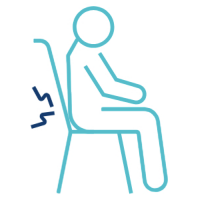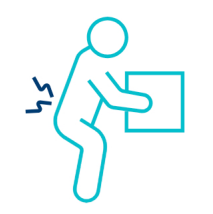Low back pain shouldn’t hold you back
Relieve your chronic low back pain with the Intracept™ Procedure and lean into life again.

“I can pretty much do anything that I want to do.”
– MIKE S.
See the procedure’s impact on real patients
About Vertebrogenic pain
Vertebrogenic pain is a distinct type of chronic low back pain caused by damage to vertebral endplates from disc degeneration or simply wear and tear from everyday life. Patients often describe vertebrogenic pain as being in the middle of their low back and made worse by:

Activity

Sitting

Bending

Lifting
Here’s what patients are saying
At five years following a single Intracept Procedure:

A procedure for proven relief
The Intracept Procedure involves heating the basivertebral nerve with a radiofrequency probe to stop it from sending pain signals to the brain.

Talking to a doctor is the first step to relief
Use our Find a Doctor tool to connect with an Intracept- trained physician near you and get back to the important things, with less chronic low back pain.
1. Fischgrund J, Rhyne A, Macadaeg K, et al. Long-term outcomes following intraosseous basivertebral nerve ablation for the treatment of chronic low back pain: 5-year treatment arm results from a prospective randomized double-blind sham-controlled multi-center study. Eur Spine J. 2020;29(8):1925-34. doi.org/10.1007/s00586-020-06448-x
Results from clinical studies are not predictive of results in other studies. Results in other studies may vary.
NM-1934306-AA
Indications for Use: The Intracept™ Intraosseous Nerve Ablation System is indicated for patients who have had chronic low back pain for at least six months, who have tried conservative care for at least six months, and whose MRI shows features consistent with Modic changes – indicating damage at the vertebral endplates has led to inflammation. Not every patient who meets these criteria is a candidate for the Intracept Procedure, however – in fact, there are specific characteristics indicating a patient should not be considered for the procedure. Contraindications include being pregnant, having weakened cardiac or pulmonary function, having an active implanted electronic medical device in the body (such as a pacemaker or defibrillator), being diagnosed with a systemic or local infection, or having an anatomy that could be damaged unintentionally while ablating the basivertebral nerve (based on your physicians’ clinical review). The Intracept Procedure is also contraindicated in patients who are skeletally immature – which generally means individuals under the age of 18 are not candidates. There are also certain risks and precautions regarding the procedure which you should be aware of before proceeding. Talk with your doctor about what indicates, and contraindicates, certain patients for the Intracept Procedure – as well as the risks and precautions for the procedure. For complete indications for use, contraindications, warnings, precautions, and side effects visit www.relievant.com/intracept.
Caution: U.S. Federal law restricts this device to sale by or on the order of a physician.

